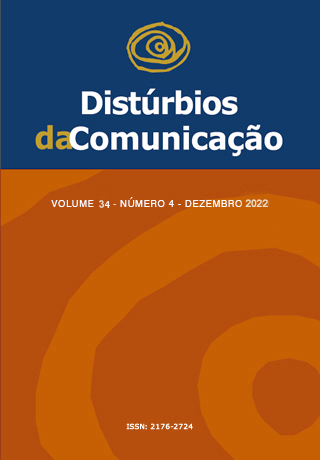Language disorders in people who communicate using sign language
an integrative review
DOI:
https://doi.org/10.23925/2176-2724.2022v34i4e57098Keywords:
Sign language, Language disorders, LanguageAbstract
Introduction: When a language disorder presents itself since childhood and is not diagnosed or treated, regardless of the language and its modality, it can have a series of consequences, in all stages of life. Purpose: To identify and analyze the scientific production that addresses the occurrence of language disorders in deaf people who communicate using sign language. Research strategies: Search in national and international literature in databases Embase, ERIC, LILACS, PubMed and Scielo. The guiding question was “How does Speech Language Therapy address the cases of deaf signers who are affected by language disorders in this modality?”. Selection criteria: Manuscripts that addressed speech language therapy practices in language disorder conditions in a population of deaf signers. Results: 295 articles were identified; after applying the eligibility criteria, eight were included in the analysis. The time interval found between publications was 12 years (from 2007 to 2018); most studies were from the United Kingdom, with observational design and with a restricted sample. Conclusion: The number of studies that address language disorders in deaf sign children is scarce, especially in the national context. This finding evidences the need for studies that address speech language therapy intervention practices in these disorders, enabling the training of speech language therapists regarding clinical practices.
Downloads
References
Pedroso FS, Rotta NT, Danesi MC, Avila LN de, Savio CB. Evolução das manifestações pré-linguísticas em crianças normais no primeiro ano de vida. Revista da Sociedade Brasileira de Fonoaudiologia [online]. 2009, v. 14, n. 1, pp. 22-25.
Morgan G, Herman R, Woll B. Language impairments in sign language: Breakthroughs and puzzles. International Journal of Language and Communication Disorders. 2007 Jan; 42(1): 97–105.
Lodi ACB, Moura MC de. Primeira língua e constituição do sujeito: uma transformação social. ETD - Educação Temática Digital, 2008, v. 7, n. 2, p. 1–13, 2008.
Dizeu LCTB, Caporali, SA. A língua de sinais constituindo o surdo como sujeito. Educação & Sociedade [online]. 2005, v. 26, n. 91, pp. 583-597.
Barbosa FV. Avaliação das habilidades comunicativas de crianças surdas: a influência do uso da língua de sinais e do português pelo examinador bilíngue. Revista da Sociedade Brasileira de Fonoaudiologia [online]. 2007, v. 12, n. 4, pp. 346.
Barbosa FV, Lichtig I. Protocolo do perfil das habilidades de comunicação de crianças surdas. Revista de estudos da linguagem. 2014, v. 22, n. 1, p. 95-118.
Brasil. Lei nº 10.436, de 24 de abril de 2002. Dispõe sobre a Língua Brasileira de Sinais e dá outras providências. Diário Oficial da União, Brasília, 25 de abril de 2002.
Brasil. Decreto nº 5.626, de 22 de dezembro de 2005. Regulamenta a Lei nº 10.436, de 24 de abril de 2002, que dispõe sobre a Língua Brasileira de Sinais – Libras, e o art. 18 da Lei nº 10.098, de 19 de dezembro de 2000. Diário Oficial da União, Brasília, 23 de dezembro de 2005.
Guarinello AC, et al. A disciplina de Libras no contexto de formação acadêmica em Fonoaudiologia. Revista CEFAC [online]. 2013, v. 15, n. 2, pp. 334-340.
Prates LCS, Martins VO. Distúrbios da fala e da linguagem na infância. Revista Médica de Minas Gerais. 2011; 21(4): 54–60.
American Psychiatric Association. Manual diagnóstico e estatístico de transtornos mentais: DSM-5. Tradução Maria Inês Corrêa Nascimento et al. Revisão Técnica Aristides Volpato Cordioli et al. 5. ed. Porto Alegre: Artmed, 2014.
Moura MC, Begrow DDV, Chaves ADD, Azoni CAS. Fonoaudiologia, língua de sinais e bilinguismo para surdos. CODAS. 2021; 33(1): 1–2.
Barbosa FV. A Clínica Fonoaudiológica Bilíngue e a Escola de Surdos na Identificação da Língua de Sinais Atípica. Educação & Realidade. 2016 Sep; 41(3): 731–54.
Cripps JH, Cooper SB, Supalla SJ, Evitts PM. Meeting the Needs of Signers in the Field of Speech and Language Pathology. Communication Disorders Quarterly. 2016; 37(2): 108–16.
Mason K, Rowley K, Marshall CR, Atkinson JR, Herman R, Woll B, et al. Identifying specific language impairment in deaf children acquiring British Sign Language: Implications for theory and practice. British Journal of Developmental Psychology. 2010; 28(1): 33–49.
Quinto-Pozos D, Singleton JL, Hauser PC. A case of specific language impairment in a deaf signer of American sign language. Journal of Deaf Studies and Deaf Education. 2017; 22(2): 204–18.
Marshall CR, Rowley K, Mason K, Herman R, Morgan G. Lexical organization in deaf children who use British Sign Language: Evidence from a semantic fluency task. Journal of Child Language. 2013; 40(1): 193–220.
Marshall C, Mason K, Rowley K, Herman R, Atkinson J, Woll B, et al. Sentence Repetition in Deaf Children with Specific Language Impairment in British Sign Language. Language Learning and Development. 2014; 11(3): 237–51.
Herman R, Rowley K, Mason K, Morgan G. Deficits in narrative abilities in child British Sign Language users with specific language impairment. International Journal of Language and Communication Disorders. 2014; 49(3): 343–53.
Guimarães CF, Campello AR e S. “Trocas nos sinais”: caracterização de processos fonológicos ocorridos durante a aquisição de Libras por pré-escolares surdos. Audiology - Communication Research. 20188; 23, e1922.
Downloads
Published
Issue
Section
License
Copyright (c) 2023 Natália de Sousa Leal Silva, Ana Manhani Cáceres-Assenço

This work is licensed under a Creative Commons Attribution 4.0 International License.









